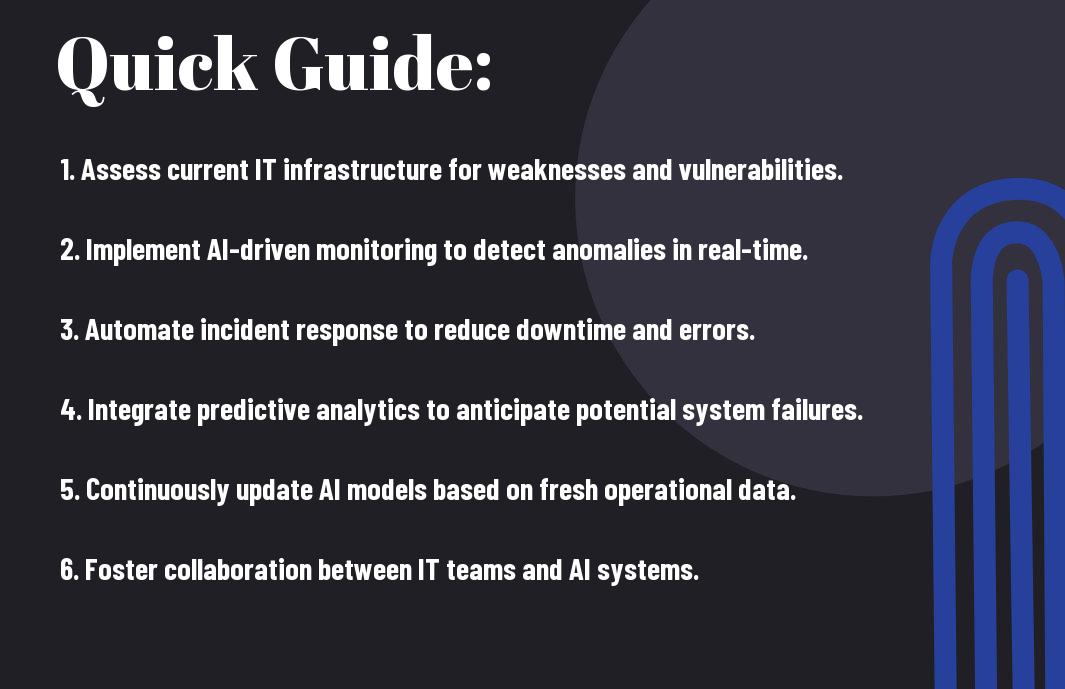AIOps revolutionizes the way you manage IT operations, providing automated analysis and insights that enhance system resilience and efficiency. By leveraging data from multiple sources, AIOps empowers your enterprise to proactively identify and resolve issues, reducing downtime and increasing operational agility. In this guide, you will explore how implementing AIOps can transform your IT landscape, enabling you to respond dynamically to challenges while driving innovation and growth in your organization.

Key Takeaways:
- AIOps can significantly enhance incident management by automating root cause analysis and streamlining resolution processes, leading to reduced downtime and improved service reliability.
- Integrating AIOps into existing IT systems enables proactive monitoring and predictive analytics, allowing enterprises to identify potential issues before they escalate.
- Effective utilization of AIOps fosters collaboration across IT teams by providing a unified platform for data sharing and insights, ultimately improving overall operational efficiency.
Decoding AIOps: The Game-Changer for IT Operations
Transforming IT operations, AIOps leverages artificial intelligence to enhance decision-making and operational efficiency. By integrating machine learning and big data analytics, AIOps not only identifies potential issues but also provides actionable insights that drive better performance. With its capability to analyze vast amounts of data in real-time, AIOps becomes a pivotal tool in anticipating disruptions and enabling faster resolutions, effectively revolutionizing how you handle IT challenges.
The Evolution of IT Management
IT management has drastically evolved from reactive monitoring to proactive problem-solving. Traditional systems often relied on manual interventions and siloed data, leading to delayed responses and increased downtime. Today’s digital landscape demands a shift towards automation and integration, paving the way for AIOps. This evolution complements agile methodologies by fostering continuous improvement and innovation within your IT operations.
What Sets AIOps Apart
AIOps stands out through its superior ability to harness data and analytics at scale. Unlike conventional tools, AIOps utilizes machine learning algorithms to synthesize information across multiple sources, providing a holistic view of your IT ecosystem. This capability enables you to predict potential problems before they affect your operations, significantly enhancing your response time. Furthermore, it allows for smarter resource allocation, reducing operational costs and improving overall efficiency.
What sets AIOps apart is its reliance on automation and real-time analytics. For instance, when a system anomaly occurs, AIOps can automatically identify the root cause using historical data patterns and insights accumulated from previous incidents. This automation means less human intervention is required, enabling your team to focus on strategic initiatives rather than getting bogged down by repetitive tasks. Additionally, AIOps streamlines collaboration among different teams, as data is consolidated into a single platform, breaking down silos that often hinder rapid decision-making. Through these distinctive features, you gain a powerful ally in enhancing system resilience and operational efficiency.

Harnessing Data: The Pillar of Resilience
Data serves as the backbone of resilient IT systems, providing the insights needed for informed decision-making. By integrating AIOps, you can unlock the potential of your organization’s data to uncover patterns and anomalies that align with your operational goals. This will ultimately lead to a more agile and responsive IT framework. Explore What is AIOps? Streamline IT operations with AI automation to understand how you can effectively leverage your data.
Real-Time Analytics for Proactive Solutions
With real-time analytics embedded in your IT operations, spotting issues before they escalate becomes second nature. This capability allows you to monitor system metrics continuously, enabling immediate alerts and responses to potential outages or performance dips. You not only save time but also enhance user satisfaction by minimizing downtime and disruptions.
Turning Data into Actionable Insights
Transforming raw data into actionable insights means you’re not just observing trends but actively engaging with them. By employing machine learning algorithms and predictive analytics, you can identify and prioritize issues that align with your strategic objectives. This proactive approach not only streamlines operations but also fosters an environment where agility thrives.
Turning data into actionable insights equips you to anticipate challenges or opportunities ahead of time. For instance, if analytics reveal that a specific application is prone to slowdowns during peak hours, you can implement solutions such as scaling resources or optimizing configurations ahead of time. This forward-thinking mindset enables your enterprise to not just react to issues but to navigate them strategically, ensuring that your IT operations align seamlessly with business goals. Being data-driven in your approach allows for effective decision-making rooted in solid evidence rather than guesswork.
Automating Responses: Enhancing IT Agility
With AIOps, automating responses to incidents facilitates a more agile IT environment. By leveraging machine learning algorithms, you can enable real-time response to common issues, significantly reducing mean time to resolution (MTTR). This automation allows your IT team to focus on strategic tasks rather than getting bogged down in repetitive operational duties, ultimately improving overall system resilience.
Streamlining Incident Management
Streamlining incident management through automation simplifies the identification and resolution of issues by integrating various tools and platforms. This cross-platform capability helps your team to quickly access vital information, enabling faster decision-making processes. Additionally, automated alerts ensure that the right personnel are notified promptly, further minimizing downtime and risk to your operations.
Creating a Feedback Loop for Continuous Improvement
Establishing a feedback loop within your AIOps framework fosters a culture of continuous improvement. By analyzing incidents after resolution, you can identify patterns and underlying root causes, allowing for more effective preventive measures. This proactive approach not only enhances system reliability but also empowers your IT team with insights that enhance their incident management strategies.
The creation of a feedback loop is necessary for refining processes and enhancing operational efficiency. By implementing automated tools that capture incident data and outcomes, you gain a wealth of information that can be analyzed to uncover trends. For example, if recurring incidents are traced back to specific systems or processes, you can take proactive steps to address these weaknesses before they escalate. Incorporating regular review sessions into your operational rhythm ensures your strategies are consistently aligned with evolving challenges, enabling a robust and agile IT infrastructure.
Building a Culture of Collaboration: Breaking Down Silos
Creating a collaborative culture within your organization is fundamental to breaking down silos that hinder communication and efficiency. When teams operate in isolation, the result is often duplicated efforts and missed opportunities for innovation. Encouraging cross-departmental initiatives and fostering an environment where sharing knowledge and resources is valued can significantly enhance operational effectiveness. With the right approach, your enterprise can harness the collective strengths of diverse teams to drive improved outcomes and adaptability.
Fostering Interdepartmental Communication
To facilitate interdepartmental communication, you can implement structured collaboration tools like platforms for shared project management and instant messaging. Regularly scheduled cross-team meetings or workshops where members exchange insights and challenges can bridge gaps. Moreover, adopting a culture of transparency regarding project updates promotes a sense of unity, enabling you to synchronize efforts and align goals throughout the organization.
The Role of AIOps in Cross-Functional Teams
AIOps plays a vital role in enhancing collaboration among cross-functional teams by synthesizing data metrics and adjusting workflows dynamically. With AIOps, disparate teams can access real-time analytics that inform their decisions, reducing the time spent on troubleshooting and allowing for faster resolution of issues. This system not only improves communication but also instills a proactive stance on incident management, enabling your teams to anticipate challenges instead of merely responding to them.
The ability of AIOps to unify data from various sources empowers your cross-functional teams to act with precision. For instance, when IT, operations, and business units leverage shared insights derived from AIOps, they can develop more cohesive strategies that address both immediate technical problems and long-term business goals. By enabling your teams to work with current, accurate information, AIOps fosters a collaborative atmosphere where everyone understands their impact on the organization’s success, ultimately enhancing resilience and adaptability in your IT systems.
Measuring Success: Key Performance Indicators for AIOps
Success in implementing AIOps hinges on well-defined Key Performance Indicators (KPIs) that track operational efficiency and overall business outcomes. Metrics such as mean time to resolution (MTTR), incident volume reduction, and customer satisfaction scores become necessary benchmarks in evaluating the effectiveness of your AIOps strategy. Utilizing a framework such as the 3S approach to AI-driven resilient operations can provide clarity in identifying and measuring these KPIs effectively.
Metrics that Matter for Operational Resilience
Focusing on specific metrics enhances your understanding of operational resilience. Key metrics include system uptime, frequency of service disruptions, and incident resolution rate. Tracking these figures helps you pinpoint vulnerabilities while ensuring continuous improvement. For instance, maintaining a 99.9% uptime within your cloud infrastructure can indicate a strong foundation for operational reliability.
Techniques for Quantifying Impact on Business Outcomes
Quantifying the impact of AIOps on business outcomes involves linking operational metrics with financial performance. This includes calculating cost savings achieved through incident automation or reductions in downtime costs, thus providing a clearer view of ROI. Establishing a direct correlation between improved operational efficiency and increased revenue is vital for long-term investments in AIOps.
To quantify impact effectively, you’ll need to analyze historical data before AIOps implementation and compare it with post-implementation results. For example, if your organization previously experienced an average of 5 hours of downtime weekly, and this figure drops to 1 hour post-AIOps, you can estimate the financial impact by applying lost revenue calculations. Such techniques not only showcase AIOps benefits, but also highlight areas for potential enhancement, reinforcing your strategy as you adapt to evolving business demands.
To wrap up
Drawing together the findings from our exploration of AIOps, it’s clear that adopting this technology can significantly enhance your enterprise operations. By leveraging AIOps, you can streamline incident management, predict system vulnerabilities, and optimize resource allocation, ultimately leading to more resilient IT systems. Implementing AIOps not only empowers your teams with actionable insights but also fosters a proactive approach to operational challenges. Embracing this innovation positions your organization to thrive in an increasingly complex digital landscape.
Q: What are AIOps and how do they contribute to building resilient IT systems?
A: AIOps, or Artificial Intelligence for IT Operations, refers to the application of machine learning and data analytics to improve IT operational processes. AIOps platforms analyze vast amounts of data generated by IT systems to identify patterns, detect anomalies, and automate incident responses. By leveraging AIOps, organizations can enhance their IT resilience by anticipating potential issues before they escalate, thereby minimizing downtime and improving overall system reliability.
Q: What are some specific benefits of integrating AIOps in enterprise operations?
A: Integrating AIOps into enterprise operations offers several benefits, including proactive incident management, real-time analytics, and improved decision-making capabilities. These platforms enable IT teams to quickly pinpoint and resolve issues, reducing response time and service disruptions. Additionally, AIOps tools provide insights into system performance, helping organizations optimize resource allocation and enhance user experiences. This leads to a more agile IT infrastructure that can effectively adapt to changing business needs.
Q: How can organizations successfully implement AIOps for enhancing their IT systems?
A: To successfully implement AIOps, organizations should start by assessing their existing IT infrastructure and identifying areas where AIOps can add value. This involves selecting the right AIOps tools that align with their specific needs and setting clear objectives for deployment. Training IT personnel on new technologies and fostering a collaborative environment between operations and development teams are also vital. Moreover, continuous evaluation and optimization of AIOps strategies will ensure they adapt to evolving demands, leading to sustained IT resilience.







